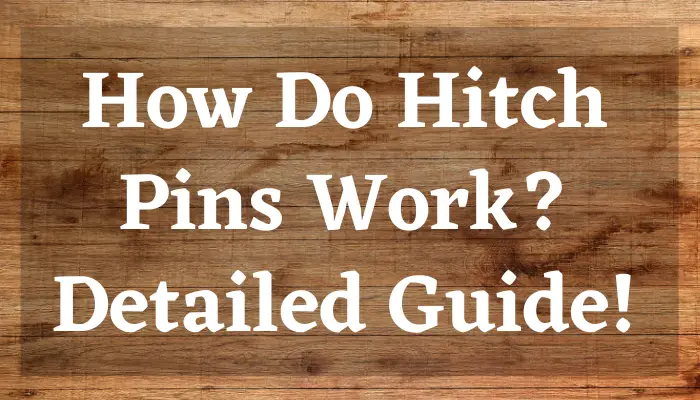This post may contain affiliate links which means I may receive a small commission for purchases made through the links. Learn More
Have you ever been driving on the highway and noticed a tractor or a trailer attached to a vehicle with a strange-looking pin holding everything together?
Let me rephrase: have you ever hitched up a trailer to your truck or used a piece of equipment that needed to be secured in place? If you have, then you have already used a hitch pin.
Hitch pins are small, unassuming devices that play a crucial role in keeping various types of equipment stable and secure. Despite their importance, hitch pins are often overlooked and underappreciated.
However, understanding how hitch pins work is vital, especially if you work in an industry that relies heavily upon towing or using hitches on a regular basis.
If you are one of those who don’t have much technical knowledge about how hitch pins work, then don’t worry. I have got your back. In this guide, I will be guiding you about the hitch pin in the guide. So, let’s dive in and discover the world of hitch pins!
Related Article: How Do You Fix a Hitch That Won’t Latch?
What is a Hitch Pin?
Before I take you into the working of a hitch pin, you should understand the basics of the hitch pin so that when I talk about advanced things then you don’t remain confused. A hitch pin is a small piece of metal with a hole running through the center. It connects two parts together, typically by being inserted through a hole in one of the parts and then secured in place with a cotter pin or R-clip.
Are you thinking about the usability of the hitch pin? Actually, this pin is actually used to secure a variety of hitch-mounted equipment, such as trailers, and other attachments, to a vehicle or tractor. These pins come in a variety of different sizes and styles to suit different applications, and different types are typically used for different purposes.
Understanding: How Do Hitch Pins Work?
The basic mechanics of how hitch pins work are quite simple. In short, the hitch pin gets inserted through a hole in one of the parts and then secured in place with a cotter pin or R-clip. This keeps the parts connected and in the correct position, allowing them to work together properly.
These pins are designed to keep the equipment securely connected, ensuring that it doesn’t come loose or fall off while in use.
Hitch pins consist of a pin body, a clip, and a spring.
- The pin body is the straight portion of the hitch pin that is inserted through the hitch and the hole in the equipment it is attached to. It is the main portion or part of the hitch pin.
- The second part is a clip which is the curved portion of the pin that holds it in place, preventing it from slipping out of the hole.
- The spring is located between the pin body and the clip and provides tension to keep the clip in place, ensuring that the pin doesn’t come loose during use.
To use a hitch pin, you will have to insert the pin body through the hitch and the hole in the equipment you’re attaching it to, then slide the clip over the end of the pin to lock it in place. Keep in mind that you must ensure that the clip is securely in place, as any movement or vibration during use can cause the pin to come loose.
Do You Need a Hitch Pin?
If you drive a vehicle and tow it on a regular basis, then you definitely need a hitch pin as it has many advantages and makes life easier. Hitch pins are also commonly used to secure attachments on agricultural and construction equipment, such as mowers, plows, trailers, and much other equipment.
Using a hitch pin provides several benefits. It ensures that the equipment stays securely connected, preventing accidents and damage. A properly secured hitch pin can also reduce the amount of wear and tear on the equipment, by reducing or limiting the amount of movement and vibration during use. So I recommend you use a hitch pin for additional safety.
Things to Consider before using a hitch pin
If you’re new to the hitch pins then don’t go using them without reading the section below which gives you guidelines and precautionary measures to ensure that you don’t suffer any problems.
- Before each use, you should always look for if there is any rust or wear & tear on the pin. If you see any rust then consider replacing any hitch pins with new ones.
- You should learn to install before using the hitch pin as an incorrect way of installing or singing can leave you in trouble. While using, make sure that pin is inserted all the way through the hole and securely fastened in place.
- To ensure the safe usage of hitch pins, it is also important to use the right type of hitch pin for the specific application. For instance, using a cotter pin for a heavy-duty application where an R-clip is needed can be dangerous and can lead to accidents.
Frequently Asked Questions
Hitch pins can be used for heavy-duty applications, but it is important to use the appropriate type of hitch pin for the specific application. I recommend you use R-clips for heavy-duty equipment.
Yes, hitch pins can be reused, but it is important to check for wear and tear before reusing them.
Hitch pins can rust, especially if they are made of steel and are exposed to moisture or humid environments. You should always check them before using and if you see rust, remove it immediately.
Conclusion
Hitch pins may seem like small, insignificant components, but their usability puts a massive impact on your towing experience. In this guide, I have given you complete information about the working of hitch pins. I hope that my effort in writing this guide will prove helpful to you.

I’m Ahmad – the owner of this website and the writer of this post. I’ve spent 15 years in the automotive industry, especially among the hitches. What you’re reading is the experience of my 15 years.

